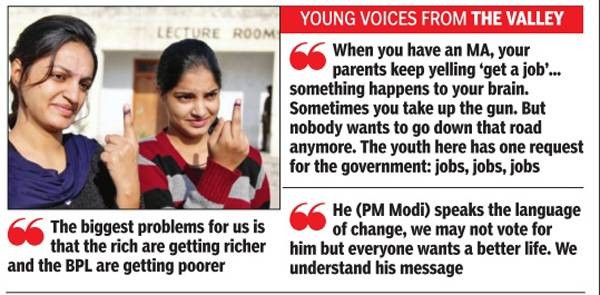Has Indian politics polarized?
 Delhi assembly election 2015 turned out to be historic. The young party (3 years old) AAP, swept away 67 out of 70 seats in the state. AAP’s thunderous winning has proved that an alternate politics is workable; because of Delhi’s prominence as India’s capital and its strength of harnessing ideas, whatever happens in Delhi resounds across the country. For the Congress, this adds to the series of its recent failures; it dint win a single seat in Delhi, a city it ruled for 15 years till 2013. People of Delhi showed their intentions towards Congress candidly.
Delhi assembly election 2015 turned out to be historic. The young party (3 years old) AAP, swept away 67 out of 70 seats in the state. AAP’s thunderous winning has proved that an alternate politics is workable; because of Delhi’s prominence as India’s capital and its strength of harnessing ideas, whatever happens in Delhi resounds across the country. For the Congress, this adds to the series of its recent failures; it dint win a single seat in Delhi, a city it ruled for 15 years till 2013. People of Delhi showed their intentions towards Congress candidly.
Anna Hazare wished Kejriwal on his victory and said the election result was in favour of AAP because the “achhe din only came for industrialists” after the NaMo-led government came to power at the Centre eight months back on a promise of great days ahead for all. The verdict will be seen as a major breach in the unshakable electoral armor of Prime Minister Narendra Modi, who campaigned hard this election in Delhi. His failure to rein in the party’s hardcore Hindutva fringe, which went about making statements that divided the middle class, cost the party dearly. The PM has also seemed in recent months as out of touch with the common man, seen frequently in the company of global leaders or local industrialists. The attention that was lavished on his clothes during US President Barack Obama is but a recent example.
This election shows that the common people of the country have become edgy towards politicians who talk big but do nothing. Arvind Kejriwal must work hard and stick to his promises to empower the common man. Dharnas only will not help; he has to mobilize popular support on subjects of common man’s interest, run a clean government, delegate powers responsibly.
This election is an indication of how Delhi’s voters have assessed Narendra Modi government in eight months tenure. The entire incremental vote the BJP won in May 2014 has been wiped out and the party’s vote share is back to what it was in 2013. Voters clearly showed their disappointment towards Modi’s performance; he has done very little for the common man.
We need to realize a fact that even the smallest amount of power can change a person. We’ve all seen it many times in our life. Someone gets a promotion or a bit of fame and then, suddenly, they’re a little less friendly to the people beneath them. Powerful people are simply too busy. They don’t have the time to fully attend to their less powerful counterparts.
 And, if you ask a psychologist, he or she may tell you that in different words. But if you ask Sukhvinder Obhi, a neuroscientist at Wilfrid Laurier University in Ontario, Canada, he might give you another explanation: Power fundamentally changes how the brain operates. Power is seductive not only because it is the means by which you can get what you want, but also because it gives you the confidence that goes along with this knowledge. Seduction is often an incremental process. It changes the perception of the person in power. Actions are justified with thoughts such as ‘just this once’ or ‘this is more important’.
And, if you ask a psychologist, he or she may tell you that in different words. But if you ask Sukhvinder Obhi, a neuroscientist at Wilfrid Laurier University in Ontario, Canada, he might give you another explanation: Power fundamentally changes how the brain operates. Power is seductive not only because it is the means by which you can get what you want, but also because it gives you the confidence that goes along with this knowledge. Seduction is often an incremental process. It changes the perception of the person in power. Actions are justified with thoughts such as ‘just this once’ or ‘this is more important’.
 Modi has seen many weathers in the Indian politics. Modi rose to power from the ground root level. But, still he underestimated the common man in India. He belongs to a right-wing political party. Right-wing politicians are activities that view some forms of social hierarchy or social inequality as either inevitable or natural typically justifying this position on the basis of natural law or tradition. AAP, on the other hand, is a modern, urban left-wing political party. Kejriwal a young IRS (Indian Revenue Services) seems raw, yet gutsy in his outlook. There is general feeling that the left-wing politicians are progressive, communists, democratic socialists, secularists, feminists and anti-capitalists. But AAP unlike its doctrine of ‘Left’ does not source its power from industrial unions but is a coalition of the urban underclass, minority groups and left-liberal intellectuals and middle-class people. AAP represents an emerging bipolarity in Indian politics. Delhi 2015 election has showcased a pattern for the politics for the 2020s and 2030s.
Modi has seen many weathers in the Indian politics. Modi rose to power from the ground root level. But, still he underestimated the common man in India. He belongs to a right-wing political party. Right-wing politicians are activities that view some forms of social hierarchy or social inequality as either inevitable or natural typically justifying this position on the basis of natural law or tradition. AAP, on the other hand, is a modern, urban left-wing political party. Kejriwal a young IRS (Indian Revenue Services) seems raw, yet gutsy in his outlook. There is general feeling that the left-wing politicians are progressive, communists, democratic socialists, secularists, feminists and anti-capitalists. But AAP unlike its doctrine of ‘Left’ does not source its power from industrial unions but is a coalition of the urban underclass, minority groups and left-liberal intellectuals and middle-class people. AAP represents an emerging bipolarity in Indian politics. Delhi 2015 election has showcased a pattern for the politics for the 2020s and 2030s.
 People want a change for better, for peace, for safety and for transparency. Delhi showcased urban-centric political geographies which will inevitably find space for an economic left and right and for their contest. As such, this new model of politics is not a war between pro changes or anti change. That is why AAP now in Feb 2015 and the BJP in May 2014 have experienced huge swings from voters. This happened in the society which is bursting with ambition and hope, and is hungry for change and a better life; for jobs and economic betterment, for dignity in the face of authority, and for some answer to everyday corruption. In fact, that is why the voters brought Modi in power in May 2014. The ‘say-do’ ratio of his government has been disturbing people. The disquiet has now percolated to voters. In that sense, this is the BJP’s defeat, but it is also Modi’s defeat. Modi is supposed to assess, look inwardly along with his party workers before it is too late.
People want a change for better, for peace, for safety and for transparency. Delhi showcased urban-centric political geographies which will inevitably find space for an economic left and right and for their contest. As such, this new model of politics is not a war between pro changes or anti change. That is why AAP now in Feb 2015 and the BJP in May 2014 have experienced huge swings from voters. This happened in the society which is bursting with ambition and hope, and is hungry for change and a better life; for jobs and economic betterment, for dignity in the face of authority, and for some answer to everyday corruption. In fact, that is why the voters brought Modi in power in May 2014. The ‘say-do’ ratio of his government has been disturbing people. The disquiet has now percolated to voters. In that sense, this is the BJP’s defeat, but it is also Modi’s defeat. Modi is supposed to assess, look inwardly along with his party workers before it is too late.
The 2015 Delhi Assembly elections show ousting of the historical departure of Indian politics. The capital of the nation stands critically polarized on socio-economic lines, or if we used Marxist terminology, one can say the general public of Delhi is mainly divided between the ‘haves’ and the ‘have-nots’. Conventionally, the term polarization in Indian politics is used in the context of religion, and caste. The British were successful to divide and rule the nation; but today the scene is changed. Those caste based vote banks are vanishing from the scene. In a historical departure, Delhi moved away from such polarizations and went to polls, when the electorate in the city appeared to be vertically divided on socio-economic lines. Delhi is much more cosmopolitan than any other city of the country. In the last 20 years, the entire demography of Delhi has changed. In post liberalization of Indian economy in the early 90s, Delhi witnessed a booming economy and population influx from bankrupt regions in search of better opportunities in the city; since then it is changing every day. Delhi also has an intelligent class of population and they cannot be underestimated.
Globalization has changed the scene in India. The Generation Y wants to surge ahead. They are a bigger vote bank. They are desperate for change. They are impatient and edgy. One doesn’t know if Arvind Kejriwal will be able to change the world or more so Delhi, but he and his small group of men have provided hope to those who worry about basic comforts and future.













































